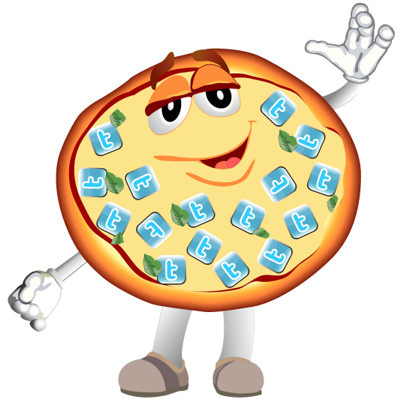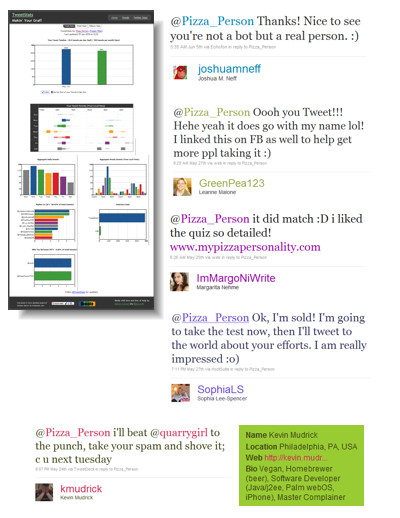Do you want spam on your pizza personality? A Twitter case study
A month and over 600 responses into the My Pizza Personality project and my disillusionment with Twitter has solidified like congealed cheese. After weeks of selling any self-respect in 140 characters or less, I now have a bad taste in my mouth. However, that won’t stop me from going back for seconds with the thought that the next bite might be different.

Pizza Personality Project Purpose
One of the hypotheses behind the My Pizza Personality project is that social media communities may mitigate barriers to environmental purchases. This is based on premise that:
1) environmental purchases require greater cognitive effort;
2) trust reduces the amount of cognitive effort in purchases; and
3) trust is built in community.
It stands to reason then that people who share ideologies in trusted social media communities would be more willing to engage with brands that shared both those ideals and participated in those communities. The issue with Twitter, however, is that everyone’s talking, but I am not convinced that anyone is listening.
Spam Disclaimer
First, a disclaimer: I am not advocating spam. By spam I mean unsolicited notifications you can’t avoid. Complaining about spam on Twitter, however, is a bit hypocritical.
Twitter allows everyone to have a conversation with everyone. I mention your name in my tweet and I am now having a conversation with everyone plus you. It is like a preacher on a corner soap box saying your name as you walk by.
Domino’s Pizza “holdouts” campaign in the States mentioned people by name who had not tried their pizza. Instead of telling everyone they need to try their pizza through mass communications channels like TV or mail drops, they said, “Scott, you need to try our pizza!”
You can see how this presents a grey area for the spam category. What if instead of pizza the product was Viagra: “Scott, you need Viagra!”. What if Scott was in the process of a mental meltdown or arguing with his family when the press rushed his door? Tricky.
With My Pizza Personality, I am not offering blue pills or Nigerian scams. I am offering a potentially fun personality test for your contribution to research. When you post on Twitter, you start the conversation with the world by saying something about topics related to my research. All I am doing is fulfilling my duty as an active listener by responding.
The Approach
My Twitter engagement strategy was very intentional. I am not building brand loyalty. I do not care about followers. I am not even interested in retweets so much. I want people to take the survey, and after they take the survey, to tell their friends. That is my business objective. There is no re-acquisition, no customer retention. After we do business, we’ve had our fling and we go our separate ways with a shared sense of slight satisfaction.
Like the dating scene, I found face to face and direct emails friend referrals were the best way to get potential respondents into proverbial pizza bed with me. Friends telling friends on Facebook also yields profitable conversions. Twitter on the other hand, not so much.
On its packaging, Twitter presents itself as a massive conversation between everyone in the world. I’ll buy that proposition, since I want to have a conversation with anyone talking about the environment, personality or pizza. So with my Tweetdeck set up to search accordingly, I started chatting.
The results

So how did it work? If time and my short attention span were not factors, I would still be at it. For my average 25 tweets per day at around 2 minutes per tweet, I yielded between 2 to 10 survey completions per day. My time-to-tweet was high based on checking out conversation starters before I tweeted, looking at recent tweets and any links and details in the person’s Twitter profile.
Outside of the majority silence, I only had one person call me out for being a spammer. His Twitter status states he is a Master Complainer, so I can write him off my conscience. On the contrary, I had many engage with my schpeel (like here, here, here, and here).
I also went 1% over my monthly data usage on my iPhone and fell behind in my assignments due to using my transit time to tweet. Hence, why I am now looking into other less resource-intensive methods such as search engine optimisation and paid advertisement.
Twitter Teachings
So what did I learn through this?
- If you are going to talk at me, know who I am.
Responding in Twitter requires finesse and insight into who you are shouting at. To talk about something, you need to find a common point of interest. The more I knew about the users, the better they responded. - Numbers do not mean influence
I was so excited when I was re-tweeted by my first user who had over 1,000 followers. I frantically checked my stats… and saw 2 people clicked through as a result. In the Twitter world, there seems to be a sweet spot of around 150 followers that yield the most engaged responses. - Trending topics are stated, not all are followed
If everyone is talking about something, it does not mean anyone is listing. My toe dipping into the Justin Bieber craze resulted in no results apart from my own personal shame and regret for selling out that much more. - It takes time to do it right
I suppose setting up auto-tweets based on keywords would have been more profitable in actual traffic. However, I did want to maintain some sense of self-respect and credibility. I am also proud of my 13% bounce rate, which indicates that those who do follow the link through don’t just leave after the first page based on an unsolicited link.
Moving forward
If you tweet about pizza, personality, or the environment, don’t be surprised if I occasionally inject myself into your own public Twitter conversation. It will be less frequent, however, as my tweets become less obsessive compulsive in favour of new channels to gain participants.
I also have to be careful about biasing my results based on the value proposition I am targeting, be it pizza lovers or environmentalists. As it is, I feel the results showing 20% of my respondents as active Twitter users are a bit high for the standard population.
I welcome your comments into my approach, or your own experiences in the pizzafied Twittershpere.

1 thought on “Do you want spam on your pizza personality? A Twitter case study”
Comments are closed.